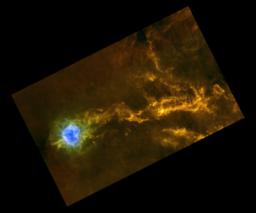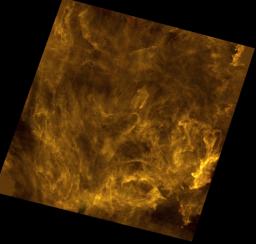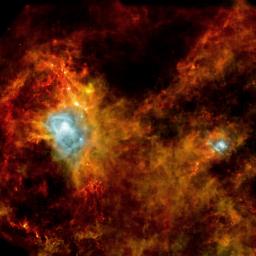 |

|
|
Gould Belt public outreach
The best Herschel images & results
Dense filaments of gas in the IC5146 interstellar cloudThis colour-composite image of IC 5146 shows the extended filamentary structure of this star-forming cloud. A detailed study of this complex has shown a total of 27 filaments that all appear to have very similar widths, with a value of about 0.3 light years. Over 350 compact starless cores have been detected embedded in the filaments in this region: about 45 of these are gravitationally bound, pre-stellar core candidates, the seeds of future stars. All pre-stellar cores are located in the densest, unstable filaments of the cloud - mostly along the main filamentary streamer visible in the central part of the image. The glowing cavity on the left side of the image, also known as the Cocoon Nebula, is an HII region, where a young and bright B0 star illuminates the ionised hydrogen gas, causing it to shine. Some young stellar objects are visible as bright spots along the main filaments; many other young stellar objects are located in the Cocoon Nebula but are not visible in this image. Located at a distance of about 1500 light years, the IC 5146 complex belongs to the Gould Belt, a giant ring of stars and star-forming clouds in the vicinity of the Sun. ESA’s Herschel space observatory has revealed that nearby interstellar clouds contain networks of tangled gaseous filaments. Intriguingly, each filament is approximately the same width, hinting that they may result from interstellar sonic booms throughout our Galaxy. Such filaments in interstellar clouds have been glimpsed before by other infrared satellites, but they have never been seen clearly enough to have their widths measured. Now, Herschel has shown that, regardless of the length or density of a filament, the width is always roughly the same. This image was taken by ESA’s Herschel space observatory at infrared wavelengths 70, 250 and 500 microns. Stars are forming along these filaments. Credit: ESA/Herschel/SPIRE/PACS/D. Arzoumanian (CEA Saclay) for the “Gould Belt survey” Key Programme Consortium. The network of interstellar filaments in PolarisThe network of interstellar filaments in Polaris as imaged by ESA’s Herschel space observatory at infrared wavelengths 250, 350 and 500 microns. These filaments are not yet forming stars. This colour-composite image of the Polaris Flare shows the extended filamentary structure of this quiescent cloud, located at a distance of about 490 light years, and characterised by little or no current star formation activity. A detailed study of this complex has revealed more than 60 filaments, 31 of which have been measured in detail. They all appear to have very similar widths, with a value of about 0.3 light years. More than 300 compact starless cores have been detected embedded in the filaments in this region, but hardly any of them appear to be gravitationally bound, pre-stellar core candidates, the seeds of future stars. By studying this and other regions, astronomers have inferred that interstellar filaments precede the onset of star formation in molecular clouds. ESA’s Herschel space observatory has revealed that nearby interstellar clouds contain networks of tangled gaseous filaments. Intriguingly, each filament is approximately the same width, hinting that they may result from interstellar sonic booms throughout our Galaxy. The filaments are huge, stretching for tens of light years through space and Herschel has shown that newly-born stars are often found in the densest parts of them. Such filaments in interstellar clouds have been glimpsed before by other infrared satellites, but they have never been seen clearly enough to have their widths measured. Now, Herschel has shown that, regardless of the length or density of a filament, the width is always roughly the same. The analysis shows that filaments precede star formation and, in some cases, pave the way for it. The Polaris Flare, with its intricate web of interstellar filaments, none of which appear to be above the mass threshold, offers an example of the state of a molecular complex prior to the onset of star formation. Credits: ESA and the SPIRE & PACS consortia, Ph. André (CEA Saclay) for the "Gould’s Belt survey" Key Programme Consortium, and A. Abergel (IAS Orsay) for the "Evolution of Interstellar Dust "Key Programme Consortium. Inside the Dark Heart of the EagleA previously unseen stellar nursery comes into view in this Herschel image. Seven hundred newly forming stars are estimated to be crowded into these colourful filaments of dust. The complex is part of a mysterious ring of stars called Gould’s Belt. This image shows a dark cloud located 1000 light years away in the constellation Aquila, the Eagle. It covers an area 65 light years across and is so shrouded in dust that no previous infrared satellite has been able to see into it. Now thanks to Herschel’s superior sensitivity at the longest wavelengths of infrared, astronomers have their first picture of the interior of this cloud. It was taken on 24 October 2009 using two of Herschel’s instruments: the Photodetector Array Camera and Spectrometer (PACS) and the Spectral and Photometric Imaging Receiver (SPIRE). The two bright regions are areas where large newborn stars are causing hydrogen gas to shine. Embedded within the dusty filaments are 700 condensations of dust and gas that will eventually become stars. Astronomers estimate that about 100 of these are protostars, celestial objects in the final stages of formation. Each one just needs to ignite nuclear fusion in its core to become a true star. The other 600 objects are insufficiently developed to be considered protostars, but these too will eventually become another generation of stars. This cloud is part of Gould’s Belt, a giant ring of stars that circles the night sky because the solar system just happens to lie near the centre of the belt. For more than a hundred years, astronomers have puzzled over the origin of this ring, which is tilted to the Milky Way by 20 degrees. The first to notice this unexpected alignment, in the mid-nineteenth century, was England’s John Herschel, the son of William, after whom ESA’s Herschel telescope is named. But it was Boston-born Benjamin Gould who brought the ring to wider attention in 1874; hence its name. Gould’s Belt supplies bright stars to many constellations such as Orion, Scorpius and Crux, and conveniently provides nearby star-forming locations for astronomers to study. Observing these stellar nurseries is a key programme for Herschel, which aims to uncover the demographics of star formation and its origin. In other words, the quantities of stars that can form and the range of masses that such newborn stars can possess. As well as this region of Aquila, Herschel will target fourteen other star-forming regions as part of the Gould’s Belt Key Programme. Credit: ESA and the SPIRE & PACS consortia, Ph. André (CEA Saclay) for the Gould’s Belt Key Programme Consortia #35 - Last update : 03/16 2015
• Herschel |
| |Galerie multimédia|liens utiles|mentions legales |



